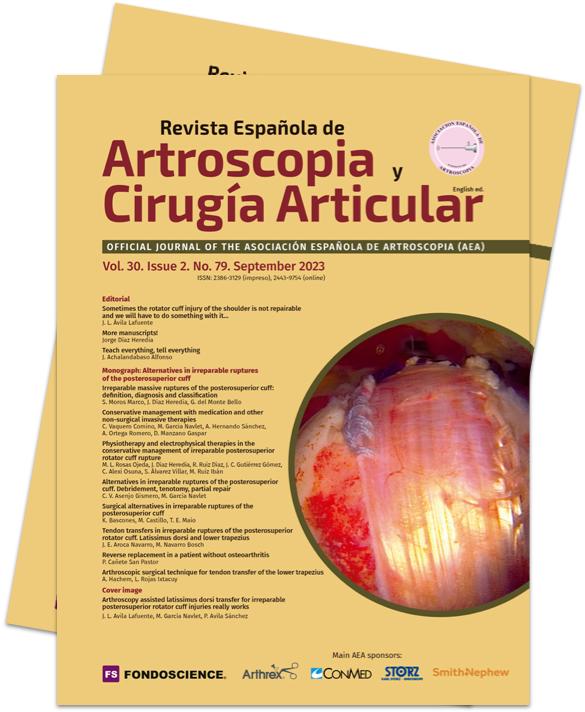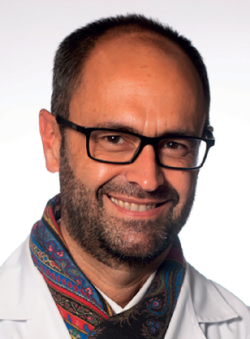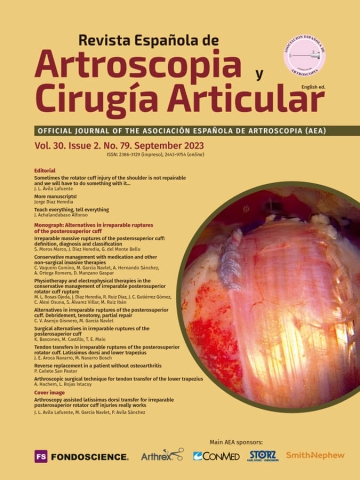In the traumatology clinic we often see patients with shoulder pain associated to a loss of active mobility and strength. Following the usual anamnesis, inspection and exploration procedures, together with some complementary tests, we reach a presumptive diagnosis in which injuries of the rotator cuff tendons play a central role.
On the basis of the disease condition we face, and with the aim of offering the best possible treatment for our patients, we fully dedicate ourselves to give our diagnosis a name. The more detailed the name, the greater the chances of defining a correct management strategy. Such names and terms include full or partial thickness; partial or complete rupture; the involvement of one or more tendons, and which tendons; the degree of retraction of rupture; the extent of the defect; the size, thickness and quality of the tendon stump; the volume, quality and adipose degeneration of the muscle mass of the damaged tendon; static elevation of the humeral head; and the critical angle of the shoulder on the radiographs. Taking these aspects (and surely also others) into account is crucial for defining the best management strategy.
This lesion typification with its names, associated to the individual circumstances of each patient; a disease history in the form of diabetes, immune depression, arterial hypertension or hypercholesterolemia; toxic habits such as alcohol and smoking; previous tendon rupture and surgery; fractures; osteoarthrosis; joint stiffness; time from onset of the lesion, etc., in some cases leads to the diagnosis of irreparable rupture of the rotator cuff.
A number of important authors such as Cofield, Gerber or Nobuhara have helped traumatologists to express themselves in similar ways in defining massive rotator cuff rupture, and Hamada, Goutallier, Fuchs, Patte, Sugaya and many others have done the same in relation to the term "irreparable rupture". This humble monograph seeks to serve as a homage all the contributing investigators - both those mentioned above and those that remain to be mentioned.
Once the diagnosis of irreparable damage of the rotator cuff has been established, and based on the aforementioned names or terms, our efforts focus on restoring patient quality of life as far as possible, minimizing pain and ensuring marked recovery of shoulder function and strength. In order to do this, we have a therapeutic repertoire at our disposal which we must know well and be able to apply correctly. Some more conservative treatments, such as changes in lifestyle, medication, physiotherapy and minimally invasive techniques for pain control, can be used on an isolated basis, combined with or associated to surgery, in order to obtain good management outcomes. Surgery (usually arthroscopic surgery) will prove necessary to improve the condition of the injured patients. Considering the irreparable nature of the rotator cuff injury, the objective of the surgery (palliative in all cases, not curative) may be as simple as debridement of the lesion, biceps tenotomy, bursectomy and acromioplasty; something a little more complex such as partial repair, the interpositioning of spacers, or superior capsule reconstruction; or even more complex procedures aimed at motorization of the shoulder, such as musculotendinous transfers or even reverse arthroplasty.
This monographic issue of the Revista Española de Artroscopia y Cirugía Articular offers clear and systematic guidelines for the diagnosis of irreparable rotator cuff injuries, together with a description of the surgical and non-surgical management options. Our hope is that thanks to the contribution of a number of magnificent young authors - all professionals of shoulder surgery in our country - the readers may enjoy this issue and consolidate their knowledge with a view to applying what has been learned to their daily practice. I hope you find it as interesting as I have.
José Luis Ávila-Lafuente
Upper Limb Unit
Department of Traumatology
Hospital MAZ Zaragoza (Spain)
Invited editorial member






